
URANOPHANE
Specimen urn-1
$ 40.00
Dims: 1.1" x 0.8" x 0.6" (2.8 x 2.0 x 1.5 cm)
Wt: 10.1 g w/ foam base
Poison Canyon, near Grants, New Mexico, U.S.A.
This small thumbnail specimen consists of a compact mass of fibrous Uranophane crystals that are partially embedded in a pale brown limestone matrix. The fibers seem to have a radiating tendency, as they emanate from a few different points in the mass, and do not exceed 0.3" (7 cm) in length. They have a bright yellow coloration and a rather dull, waxy luster, and may be translucent, though this feature is nearly impossible to test. The patch is surrounded by and likely rests upon a cluster of dark, brown/black crystals that I believe are calcites. I think that radiation from the Uranophane has darkened them, though I am unsure. The piece is glued onto a foam base with a hot glue; the foam base, in turn, fits snugly into the bottom of the plastic specimen box that houses the specimen.

 Amethyst Galleries' Mineral Gallery MINERALS |

URANOPHANE specimen urn-1
$ 40.00
$ 40.00
Dims: 1.1" x 0.8" x 0.6" (2.8 x 2.0 x 1.5 cm)
Wt: 10.1 g w/ foam base
Poison Canyon, near Grants, New Mexico, U.S.A.
This small thumbnail specimen consists of a compact mass of fibrous Uranophane crystals that are partially embedded in a pale brown limestone matrix. The fibers seem to have a radiating tendency, as they emanate from a few different points in the mass, and do not exceed 0.3" (7 cm) in length. They have a bright yellow coloration and a rather dull, waxy luster, and may be translucent, though this feature is nearly impossible to test. The patch is surrounded by and likely rests upon a cluster of dark, brown/black crystals that I believe are calcites. I think that radiation from the Uranophane has darkened them, though I am unsure. The piece is glued onto a foam base with a hot glue; the foam base, in turn, fits snugly into the bottom of the plastic specimen box that houses the specimen.


urn-1 ($ 40.00)
Poison Canyon, near Grants, New Mexico, U.S.A.

URANOPHANE specimen urn-2
$ 60.00
$ 60.00
Dims: 1.9" x 1.3" x 1.1" (4.8 x 3.3 x 2.8 cm)
Wt: 2.23 oz. (63.3 g)
Poison Canyon, near Grants, New Mexico, U.S.A.
This thumbnail specimen consists of a formless "cluster" of fibrous Uranophane crystals that rest on a gray quartzite base rock. Even under 15x magnification, it is difficult to determine any crystal form, though there are a few spots where some crystals spray out. These crystals are extremely thin (I would guess about 20-40 times thinner than human hair) and due dense compactness, it is nearly impossible to determine a length. They have the standard bright yellow coloration and fibrous habit of this mineral, and do not show a noticeable glow under either long- or short-wave UV radiation.
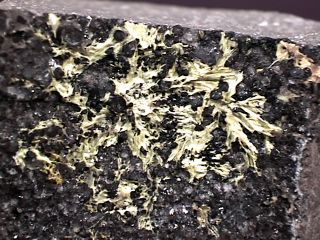

urn-2 ($ 60.00)
Poison Canyon, near Grants, New Mexico, U.S.A.

$ 100.00
Dims: 3.7" x 2.1" x 1.1" (9.4 x 5.3 x 2.8 cm)
Wt: 5.93 oz. (168.3 g)
Poison Canyon, near Grants, New Mexico, U.S.A.
Like other specimens of this mineral, this piece consists of concentrated patches of seemingly randomly-placed yellow Uranphane needles on a calcite base. The patches on this particular specimen, however, are much larger than most that I have seen, and the needles therein tend to be a bit longer and a bit more integral, so that they are easier to see. They do not exceed 0.2" (5 mm) in length, and have diameters that are much thinner than that of human hair. They have the classic bright yellow coloration of Uranophane and show a pearly luster. They are most likely translucent, though this is very difficult to determine. The calcite bed on which they rest is semicrystalline, and this in turn rests on a bed of more calcite that is much more massive and has a granular consistency.


Poison Canyon, near Grants, New Mexico, U.S.A.

URANOPHANE specimen urn-4
$ 80.00
$ 80.00
Dims: 2.5" x 2.5" x 1.6" (6.4 x 6.4 x 4.1 cm)
Wt: 5.58 oz. (158.4 g)
Poison Canyon, near Grants, New Mexico, U.S.A.
This hand specimen consists of a few compact masses of fibrous Uranophane crystals. These crystals do not exceed 0.3" (8 mm) in length and are all thinner than human hair. They have the bright yellow color and waxy luster that are characteristic of this mineral. I believe that even individual needles would be essentially opaque. They rest on a base that is made of intergrown and broken calcite crystals that grow out of a limestone matrix.


urn-4 ($ 80.00)
Poison Canyon, near Grants, New Mexico, U.S.A.

URANOPHANE specimen urn-5
$ 45.00
$ 45.00
Dims: 2.2 x 1.3 x 1.2" (5.6 x 3.3 x 3.0 cm)
Wt: 2.8 oz. (79.7 g)
Poison Canyon, near Grants, New Mexico, U.S.A.
This small hand specimen consists of a small chunk of a gray shale host rock on which lies a thin crust of both semi-crystalline and massive Uranophane. This thin crust is in moderately good condition, as a portion of it is broken and missing, and likely formed in a narrow crevice between two pieces of the shale. The fibrous, radiating crystals that are visible are heavily compacted but still discernable and reach lengths of 0.4" (1.0 g). They are, unfortunately, not isolated enough for effective study of their form. The Uranophane has a generally deep yellow coloration and a dull matte-to-waxy luster. Due to its thinness and close association with the host, it is impossible to determine its clarity, though I would think that it would be dimly translucent at best.

urn-5 ($ 45.00)
Poison Canyon, near Grants, New Mexico, U.S.A.
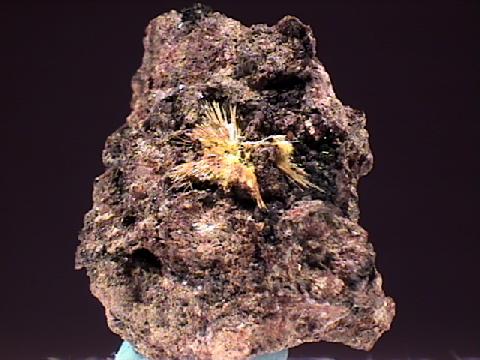
URANOPHANE specimen urn-6
$ 68.00
$ 68.00
Dims: 1.2 x 1.2 x 1.0" (3.0 x 3.0 x 2.5 cm)
Wt: 21.6 g
Madawaska Mine, Bancroft, Ontario, Canada
A single, slightly disjointed spray of Uranophane needles rests on the dull, dark brown host rock of this thumbnail specimen. The needles do not exceed 0.3" (8 mm) and are generally in very good condition, though there does seem to be some visible damage. They are rather fine and somewhat warped, so that their monoclinic form is not easy to determine, if even definable. They have the standard yellow coloration and a dull pearly-to-waxy luster, and are likely only dimly translucent at best. The brown host rock appears to contain some semicrystalline calcite and possibly some goethite. The specimen is affixed inside a large plastic specimen box with an adhesive putty.

urn-6 ($ 68.00)
Madawaska Mine, Bancroft, Ontario, Canada
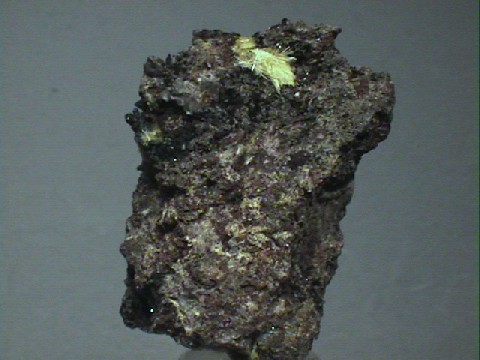
URANOPHANE specimen urn-7
$ 110.00
$ 110.00
Dims: 1.8 x 1.4 x 1.1" (4.6 x 3.7 x 2.6 cm)
Wt: 1.3 oz. (36 g)
Faraday Mine, Bancroft, Ontario, Canada
Several small Uranophane clusters rest on the crumbly base of this hand specimen. These clusters contain needles that are generally in good condition and do not exceed 0.2" (5 mm). Their monoclinic needle-like form is probably good, though they are too fine to properly study even with a loupe. All have the bright yellow color, pearly-to-waxy luster and complete opacity that are common traits of this specie. I cannot define the host material, but some black material lines the spaces where the Uranophane crystals are - I suppose that this could be some form of uranium oxide mineral. The piece registers well on a geiger-muller counter, though when placed in a box, most of the radiation is blocked.


urn-7 ($110.00)
Faraday Mine, Bancroft, Ontario, Canada

URANOPHANE specimen urn-8
$ 375.00
$ 375.00
Dims: 3.5 x 2.1 x 2.4" (8.9 x 7.9 x 6.1 cm)
Wt: 8.7 oz. (246 g)
Faraday Mine, Bancroft, Ontario, Canada
Five Uranophane sprays rest on the base of this cabinet piece. Three of the sprays contain crystals that reach lengths of 0.2-0.3", and the other two have crystals that reach 0.4". All appear to be in good condition, though one of the larger sprays is exposed and shows some obvious damage. The Uranophane needles are too fine to study without magnification, but likely have good monoclinic form. Their bright yellow color is slightly rust-stained, but standard for the specie, as is their silky luster. The base on which they rest is somewhat difficult to define, but appears to be encrusted with reniform goethite or a related oxide mineral, hence the rust-staining. Tiny crystals of what I believe is calcite are scattered among the goethite.


urn-8 ($375.00)
Faraday Mine, Bancroft, Ontario, Canada
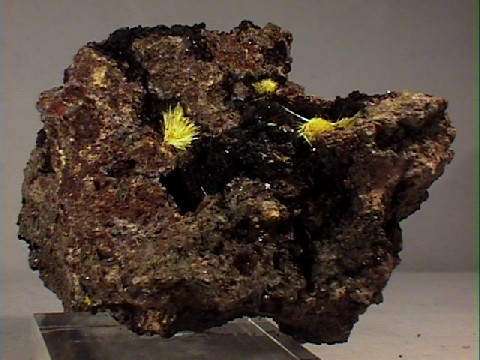
URANOPHANE specimen urn-9
$ 375.00
$ 375.00
Dims: 3.2 x 2.1 x 2.0" (8.1 x 5.4 x 5.1 cm)
Wt: 5.2 oz. (148 g)
Faraday Mine, Bancroft, Ontario, Canada
At least 8 separate and distinct Uranophane clusters rest in hollows on the gray-brown host rock of this cabinet piece. Each of these clusters is made up of several Uranophane needles that reach 0.2" (4-5mm) in length. They are generally in good condition, though a few of the more exposed needles are crushed or broken. They are too fine to effectively study their monoclinic form, and have the standard bright yellow color and silky luster of the specie. They are translucent at best and are surrounded by tiny quartz crystals that are encrusted with either massive goethite, uraninite, or both.
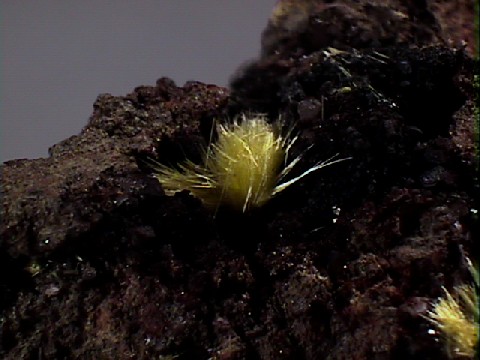

urn-9 ($375.00)
Faraday Mine, Bancroft, Ontario, Canada

URANOPHANE specimen urn-10
$ 263.00
$ 263.00
Dims: 2.2 x 2.1 x 1.8" (5.6 x 5.3 x 4.5 cm)
Wt: 3.6 oz. (101 g) w/base
Faraday Mine, Bancroft, Ontario, Canada
Four clusters of radiating Uranophane needles rest on the base of this small cabinet piece. These clusters are in good condition, showing moderate damage, and contain crystals that reach 0.2-0.3" (5-7mm) in length. They show the classic yellow color and pearly luster of the specie, and magnification is needed to properly study their monoclinic form. The clusters rest in small hollows in the host rock that appear to be lined with tiny quartz crystals and possibly uraninite. A small acrylic base is attached.
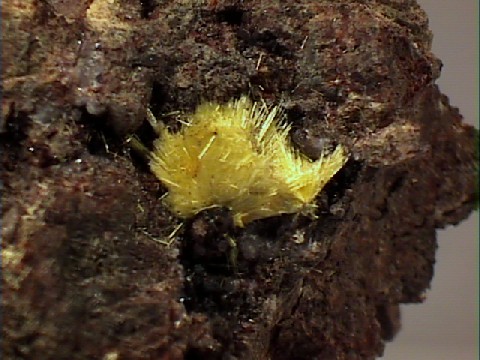

urn-10 ($263.00)
Faraday Mine, Bancroft, Ontario, Canada

URANOPHANE specimen urn-11
$ 375.00
$ 375.00
Dims: 2.3 x 2.1 x 1.9" (5.7 x 5.2 x 4.8 cm)
Wt: 4.0 oz. (114 g) w/base
Faraday Mine, Bancroft, Ontario, Canada
This hand specimen consists of a brown base rock on which rest several Uranophane sprays. These sprays are generally in good condition and each contain many fine Uranophane needles that reach up to 0.5 (1.3 cm) in length. These crystals are too fine to effectively study with a loupe, but likely have reasonably good monoclinic form. Their bright yellow color and pearly luster are standard for the specie. All are translucent at best, and likely opaque. The shallow hollows in which they rest are lined with what appear to be tiny quartz crystals, and likely some dark oxide compound.


urn-11 ($375.00)
Faraday Mine, Bancroft, Ontario, Canada